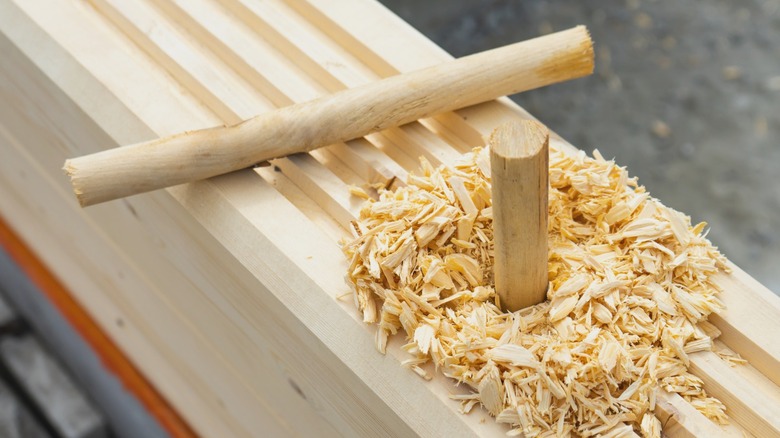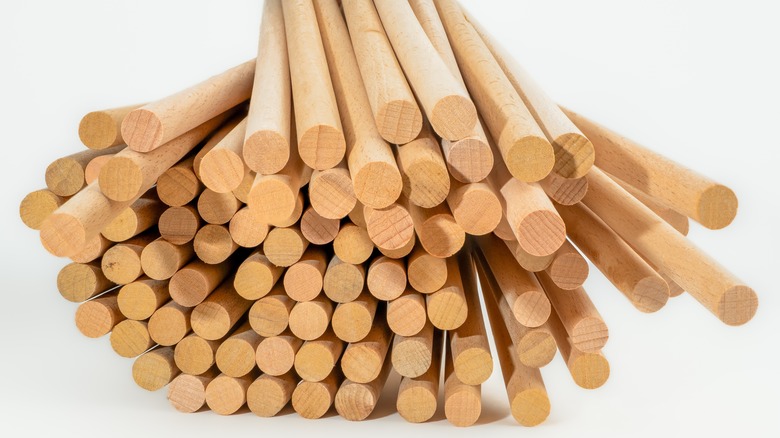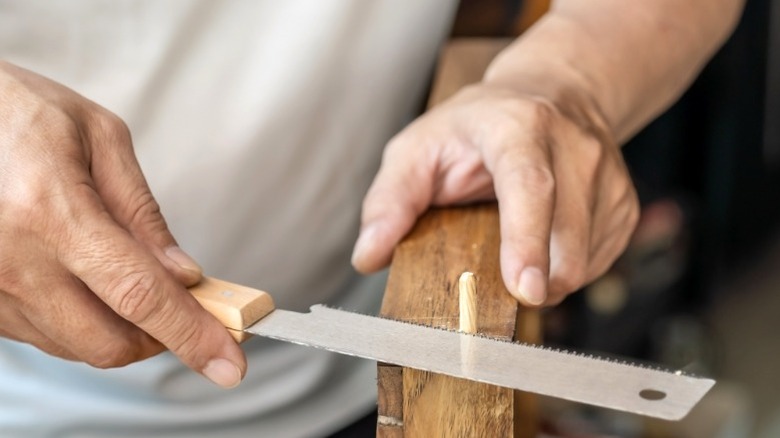Skip The Store And DIY Your Own Wood Dowels For Your Next Project
We may receive a commission on purchases made from links.
For such a simple component, crafting a wood dowel can surprisingly seem well beyond a DIYer's capacity. A perfectly rounded rod is hardly the easiest shape to free hand with the essential tools homeowners should have, making an inconvenient trip to the hardware store an apparent inevitability. Wouldn't it be nice if you could save time and money by just whipping these up at home? And wouldn't it be even nicer if you could do it without having to buy any specialty tools? Yes and yes, and as we learned in an exclusive chat with House Digest's expert carpenter and remodeler, Bob Beacham, both scenarios are totally possible with a smart woodworking hack.
All you need to make your dowels are sheet metal, a drill, and, of course, some wood stock to form. "You need a piece of ⅛-inch steel plate (or similar thickness). Don't try aluminum, it's too soft," Beacham explains. "You need a drill bit that can drill through metal and matches the size of the dowel you want to make. Drill a hole through the steel, but do not clean it up. The rough edges of the hole are what you need to help cut the dowel."
Making this rough hole creates a guide through which you can extrude thin, rectangular wood strips into round dowels. And it's no trouble if you can't drill your own holes. "If you don't have easy access to a steel plate or the bits to drill it, a number of dowel-making jigs are available," he says, noting the value of products like the DFM Tool Works Doweling Tool. Armed with this information, you're all set to make your own dowels.
Expert tips to make your DIY wood dowels
With your jig ready, start your DIY dowel project by cutting strips of wood small enough to fit in your drill chuck's jaws and jam through the metal jig's cutting hole. "You need your wood stock to make the dowel out of, cut down to a fraction over ¼-inch square and anywhere from around 8 inches to a foot long," Bob Beacham states in his House Digest exclusive interview, highlighting critical safety tips for using the table saw when cutting thin strips. "Always use a push stick to keep fingers well away from the blade."
After cutting a strip, you can taper the ends with sandpaper or a knife. "One end needs to fit in the drill chuck, the other needs to go through the hole in the steel plate to start it off," Beacham explains. "The drill is started, and the square piece of wood is forced through the hole in the steel plate. The rough edges of the hole act as a chisel to cut away the corners. What comes out the other end is a round dowel, ready for use. For different-sized dowels, drill different-sized holes and cut the stock accordingly."
Beacham emphasizes the need for a sturdy grip and a slow, steady, and firm approach. "It does take a reasonable amount of force to push the stock through the hole, so you have to be careful not to snap it. If that happens, there's a real danger of hurting yourself," he cautions. "I would clamp the steel to a bench or in a vise so you can hold the drill with both hands to guide the stock accurately."
Are DIY dowels really worth the effort?
Making your own dowels can be an efficient process for the avid woodworker, especially once you get the practice in. Still, Bob Beacham says that this may not be a woodworking project for beginners because the cost savings can be nominal, and your success largely hinges on having the proper tools. "As well as the steel plate, you need a table saw or bandsaw to cut the stock down to size," Beacham tells House Digest. "If you've only got a hand-held power saw or a miter saw (which are what many DIYers own), it will be almost impossible to cut the stock to size."
So, when should you bother with the DIY approach? Making your own wood dowels is ideal if you have certain types of wood that are rare to find as dowels elsewhere. "Most store-bought wood dowels will be pine, bamboo, or another cheap, light-colored wood. However, if you're making something out of red oak, mahogany, or any other dark hardwood, pale dots in the piece won't look very good (unless for decorative purposes)," Beacham states, adding that you can sometimes stain light-colored dowels, though it typically takes some trial-and-error. "You can find oak, mahogany, or walnut dowels in some stores, but these are more expensive and still might not match the color of your stock. As you've presumably already bought the wood for your project, making your own matching dowels with some of it could be the way to go."


